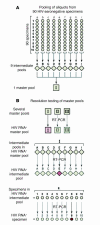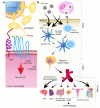Acute HIV revisited: new opportunities for treatment and prevention
- PMID: 15057296
- PMCID: PMC379335
- DOI: 10.1172/JCI21540
Acute HIV revisited: new opportunities for treatment and prevention
Erratum in
- J Clin Invest. 2006 Dec;116(12):3292
Abstract
Inability to recognize incident infection has traditionally limited both scientific and public health approaches to HIV disease. Recently, some laboratories have begun adding HIV nucleic acid amplification testing to HIV diagnostic testing algorithms so that acute (antibody-negative) HIV infections can be routinely detected within the first 1-3 weeks of exposure. In this review article, we will highlight critical opportunities for HIV treatment and prevention that are presented by these diagnostic strategies.
Figures




References
-
- Schacker T, Collier AC, Hughes J, Shea T, Corey L. Clinical and epidemiologic features of primary HIV infection. Ann. Intern. Med. 1996;125:257–264. - PubMed
-
- Pilcher CD, et al. Frequent detection of acute primary HIV infection in men in Malawi. AIDS. 2004;18:1–8. - PubMed
-
- Pilcher, C.D., et al. 2004. The “Screening and Tracing Active Transmission” (STAT) program: real-time detection and monitoring of HIV incidence. Program and abstracts: 11th Conference on Retroviruses and Opportunistic Infections. San Francisco, California, USA. Abstr. 20.
-
- Borrow P, et al. Antiviral pressure exerted by HIV-1-specific cytotoxic T lymphocytes (CTLs) during primary infection demonstrated by rapid selection of CTL escape virus. Nat. Med. 1997;2:205–211. - PubMed
-
- Lindback S, et al. Diagnosis of primary HIV-1 infection and duration of follow-up after HIV exposure. Karolinska Institute Primary HIV Infection Study Group. AIDS. 2000;14:2333–2339. - PubMed

